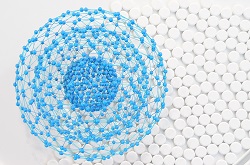Introducing the world’s biggest nanomaterial production plant
‘This new facility opens up a significant amount of new opportunities for us,’ says Professor Ed Lester, Technical Coordinator of Promethean Particles. This spin-out of the University of Nottingham is in charge of operating the new plant, which is expected to produce over 1 000 tonnes of nanomaterials every year. The production cost is lower than that of other facilities and the chosen production method - continuous hydrothermal synthesis - is expected to impact even markets for which sale prices had so far been an obstacle. ‘We have already had a lot of interest from companies in a diverse range of sectors. From healthcare, where nano-particles can be used in coatings on medical devices, to enhanced fabrics, where nano-materials can add strength and flexibility to textiles, and in printed electronics, as we are able to print materials such as copper,’ Prof. Lester continues. Solvay, Fiat, PPG and Repsol are among the major companies already set to benefit from the plant’s products. To reach these impressive levels of production, the plant notably relies on high pressure triplex plunger pumps manufactured by Cat Pumps. These pumps have helped the 18-strong consortium to overcome engineering issues related to the mixing of the heated fluid and the aqueous metal salt flow, by creating the continuous pressure and fluid flow necessary to achieve continuous production. Another enabling technology is the Nozzle Reactor, a customised design that uses buoyancy-induced eddies to produce an ‘ideal’ mixing scenario in a pipe-in-pip concentric configuration in which the internal pipe has an open-ended nozzle. This technology allows Promethean Particles to dramatically improve reproducibility and reliability whilst controlling particles properties such as size, composition and shape. Betting on hydrothermal synthesis Started in 2012, SHYMAN built upon the observation that hydrothermal synthesis had numerous advantages compared to alternatives: it doesn’t resort to noxious chemicals, uses relatively simple chemistry relying on cheap precursors, allows straightforward downstream processing, can avoid agglomeration and allows for narrow and well-controlled size and shape distribution. The optimisation of hydrothermal synthesis has been a key objective of the University of Nottingham for the past 14 years, and SHYMAN is the pinnacle: the project began with the development of bench scale reactors, followed by a 30-times-larger pilot scale reactor. The reactor at the heart of the new production plant is 80 times larger than the latter and features four Cat Pumps Model 3801 high pressure triplex plunger pumps. ‘These are very exciting times for Promethean Particles,’ said Dr Susan Huxtable, Director of Intellectual Property and Commercialisation at the University of Nottingham. ‘The new facility opens up a myriad of opportunities for them to sell their services into new markets right across the world. It is a great example of how many of the technologies developed by academics here at the University of Nottingham have the potential to benefit both industry and society.’ For more information, please see: project website
Countries
United Kingdom



